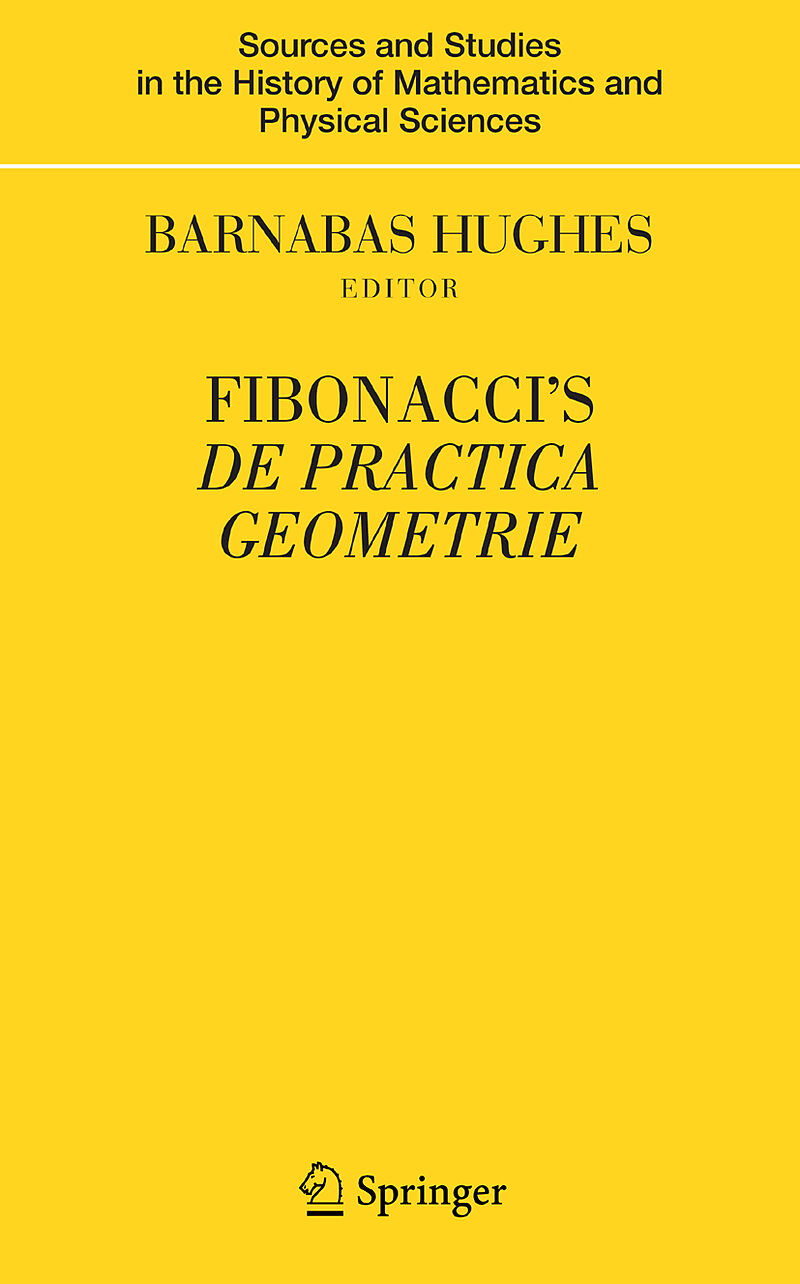Fibonacci's De Practica Geometrie
Einband:
Fester Einband
EAN:
9780387729305
Untertitel:
Sources and Studies in the History of Mathematics and Physical Sciences
Autor:
Barnabas Hughes
Herausgeber:
Springer New York
Auflage:
2008
Anzahl Seiten:
448
Erscheinungsdatum:
29.11.2007
ISBN:
0387729305
This translation offers a reconstruction of De Practica Geometrie as the author judges Fibonacci wrote it, thereby correcting inaccuracies found in numerous modern histories. It is a high quality translation and contains informative commentary preceding each chapter.
Leonardo da Pisa, perhaps better known as Fibonacci (ca. 1170 ca. 1240), selected the most useful parts of Greco-Arabic geometry for the book known as De practica geometrie. Beginning with the definitions and constructions found early on in Euclid's Elements, Fibonacci instructed his reader how to compute with Pisan units of measure, find square and cube roots, determine dimensions of both rectilinear and curved surfaces and solids, work with tables for indirect measurement, and perhaps finally fire the imagination of builders with analyses of pentagons and decagons. His work exceeded what readers would expect for the topic. Practical Geometry is the name of the craft for medieval landmeasurers, otherwise known as surveyors in modern times. Fibonacci wrote De practica geometrie for these artisans, a fitting complement to Liber abbaci. He had been at work on the geometry project for some time when a friend encouraged him to complete the task, which he did, going beyond the merely practical, as he remarked, Some parts are presented according to geometric demonstrations, other parts in dimensions after a lay fashion, with which they wish to engage according to the more common practice. This translation offers a reconstruction of De practica geometrie as the author judges Fibonacci wrote it. In order to appreciate what Fibonacci created, the author considers his command of Arabic, his schooling, and the resources available to him. To these are added the authors own views on translation and remarks about prior Italian translations. A bibliography of primary and secondary resources follows the translation, completed by an index of names and special words.
High quality translation with supplemental text to explain text that has been more freely translated Contains informative commentary preceding each chapter of text Presents the resources upon which Fibonacci based his work, thereby correcting inaccuracies found in numerous modern histories Offers numerous examples of medieval computations and logical proof regarding mathematics that was important throughout the 11th-12th centuries Includes supplementary material: sn.pub/extras
Klappentext
Leonardo da Pisa, perhaps better known as Fibonacci (ca. 1170 - ca. 1240), selected the most useful parts of Greco-Arabic geometry for the book known as De practica geometrie. Beginning with the definitions and constructions found early on in Euclid's Elements, Fibonacci instructed his reader how to compute with Pisan units of measure, find square and cube roots, determine dimensions of both rectilinear and curved surfaces and solids, work with tables for indirect measurement, and perhaps finally fire the imagination of builders with analyses of pentagons and decagons. His work exceeded what readers would expect for the topic. Practical Geometry is the name of the craft for medieval landmeasurers, otherwise known as surveyors in modern times. Fibonacci wrote De practica geometrie for these artisans, a fitting complement to Liber abbaci. He had been at work on the geometry project for some time when a friend encouraged him to complete the task, which he did, going beyond the merely practical, as he remarked, "Some parts are presented according to geometric demonstrations, other parts in dimensions after a lay fashion, with which they wish to engage according to the more common practice." This translation offers a reconstruction of De practica geometrie as the author judges Fibonacci wrote it. In order to appreciate what Fibonacci created, the author considers his command of Arabic, his schooling, and the resources available to him. To these are added the authors own views on translation and remarks about early Renaissance Italian translations. A bibliography of primary and secondary resources follows the translation, completed by an index of names and special words.
Inhalt
Measuring Areas of Rectangular Fields.- Finding Roots of Numbers.- Measuring All Kinds of Fields.- Dividing Fields Among Partners.- Finding Cube Roots.- Finding Dimensions of Bodies.- Measuring Heights, Depths, and Longitude of Planets.- Geometric Subtleties.

Leider konnten wir für diesen Artikel keine Preise ermitteln ...
billigbuch.ch sucht jetzt für Sie die besten Angebote ...
Die aktuellen Verkaufspreise von 5 Onlineshops werden in Realtime abgefragt.
Sie können das gewünschte Produkt anschliessend direkt beim Anbieter Ihrer Wahl bestellen.
Loading...
Die aktuellen Verkaufspreise von 5 Onlineshops werden in Realtime abgefragt.
Sie können das gewünschte Produkt anschliessend direkt beim Anbieter Ihrer Wahl bestellen.
| # | Onlineshop | Preis CHF | Versand CHF | Total CHF | ||
|---|---|---|---|---|---|---|
| 1 | Seller | 0.00 | 0.00 | 0.00 |
